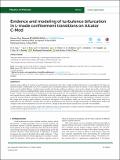Evidence and modeling of turbulence bifurcation in L-mode confinement transitions on Alcator C-Mod
Author(s)
Cao, NM; Rice, JE; Diamond, PH; White, AE; Chilenski, MA; Ennever, PC; Hughes, JW; Irby, J; Reinke, ML; Rodriguez-Fernandez, P; ... Show more Show less
DownloadPublished version (1.819Mb)
Publisher with Creative Commons License
Publisher with Creative Commons License
Creative Commons Attribution
Terms of use
Metadata
Show full item recordAbstract
© 2020 Author(s). Analysis and modeling of rotation reversal hysteresis experiments show that a single turbulent bifurcation is responsible for the Linear to Saturated Ohmic Confinement (LOC/SOC) transition and concomitant intrinsic rotation reversal on Alcator C-Mod. Plasmas on either side of the reversal exhibit different toroidal rotation profiles and therefore different turbulence characteristics despite the profiles of density and temperature, which are indistinguishable within measurement uncertainty. Elements of this bifurcation are also shown to persist for auxiliary heated L-modes. The deactivation of subdominant (in the linear growth rate and contribution to heat transport) ion temperature gradient and trapped electron mode instabilities is identified as the only possible change in turbulence within a reduced quasilinear transport model across the reversal, which is consistent with the measured profiles and inferred heat and particle fluxes. Experimental constraints on a possible change from strong to weak turbulence, outside the description of the quasilinear model, are also discussed. These results indicate an explanation for the LOC/SOC transition that provides a mechanism for the hysteresis through the dynamics of subdominant modes and changes in their relative populations and does not involve a change in the most linearly unstable ion-scale drift-wave instability.
Date issued
2020Department
Massachusetts Institute of Technology. Department of Physics; Massachusetts Institute of Technology. Department of Nuclear Science and Engineering; Massachusetts Institute of Technology. Plasma Science and Fusion CenterJournal
Physics of Plasmas
Publisher
AIP Publishing